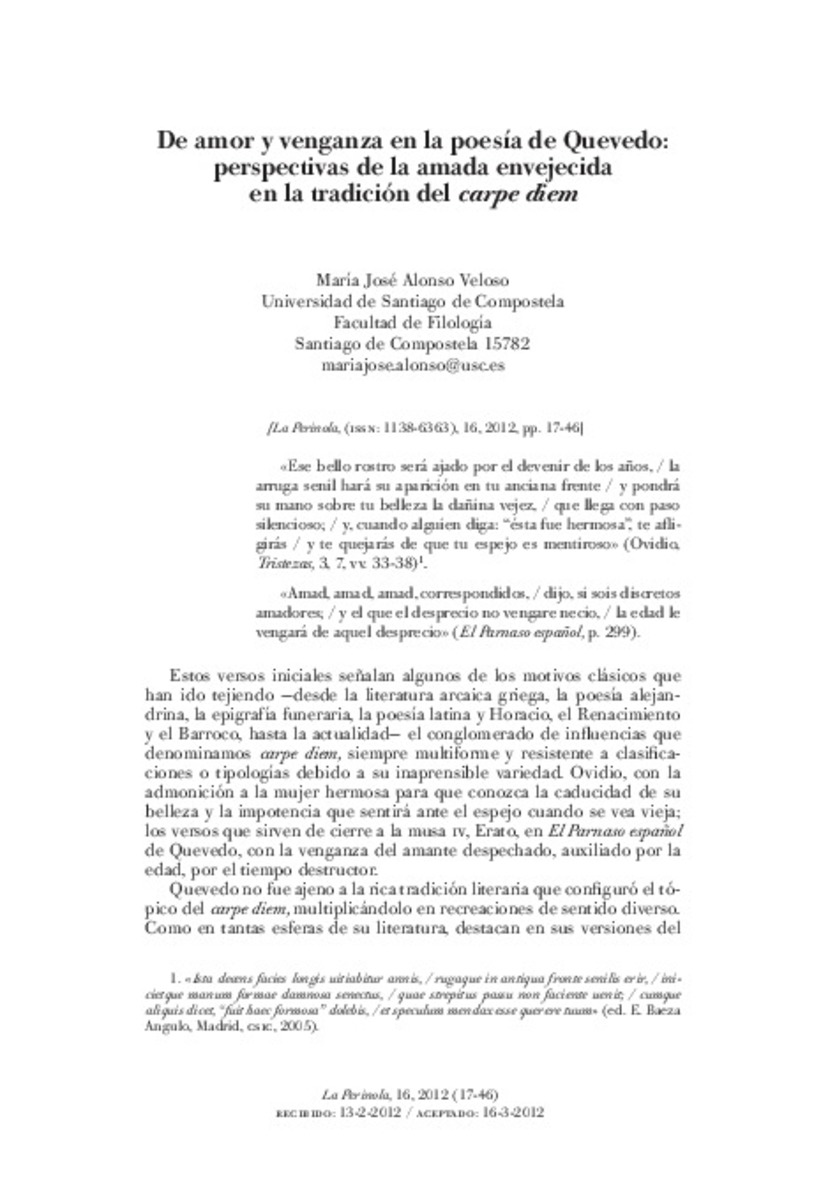Full metadata record
| DC Field | Value | Language |
|---|---|---|
| dc.creator | Alonso-Veloso, M.J. (María José) | - |
| dc.date.accessioned | 2014-06-13T10:29:53Z | - |
| dc.date.available | 2014-06-13T10:29:53Z | - |
| dc.date.issued | 2012-04-15 | - |
| dc.identifier.citation | La-Perinola | es_ES |
| dc.identifier.issn | 1138-6363 | - |
| dc.identifier.uri | https://hdl.handle.net/10171/36045 | - |
| dc.description.abstract | Las recreaciones del carpe diem en la poesía de Quevedo destacan por la densidad y variedad de sus fuentes: Ausonio, Bernardo Tasso y Garcilaso, en pasajes que asocian lo efímero de la belleza de la flor y la hermosura de la mujer; Horacio, Bembo o Herrera, en el motivo de la tópica soberbia femenina; los epigramas de la Antología griega, en la ofrenda simbólica del espejo ya inútil para la mujer madura; Propercio, Ovidio, Torquato Tasso, algunos autores marinistas y ciertas odas horacianas, en la amenaza de vejez futura o en la burla por los estragos de la edad en una bella desdeñosa ya envejecida. Esta última posibilidad parece la preferida en la lírica amorosa quevediana y muestra interesantes puntos en común con Horacio: el afán de venganza del amante contra una mujer que no aprovechó su hermosura ya perdida y el alejamiento de una voz poética que no es la del amante se antojan más próximos a la tradición de la sátira contra mulieres, a poemas satírico-burlescos sobre viejas y al «Aquí fue Troya de la hermosura» que a las imágenes habituales en un cancionero amoroso con reminiscencias petrarquistas. Quevedo used many models in his poems about «carpe diem»: Ausonio, Bernardo Tasso or Garcilaso, when he associates the vanishing beauty of flowers and women. Horacio, Bembo or Herrera, in the topic of the proud women; the epigrams of the Greek Anthology, in the symbolic offer of the useless mirror for the old woman; Propercio, Ovidio, Torquato Tasso, some marinistas and certain horacian odes, in the threat of future oldness or the mockery against a woman once beautiful and old now. This possibility, maybe due to Horacio’s influence, is the most frequent; it is closer to contra mulieres satire, the satiric and burlesque poems about old women or the «Aquí fue Troya de la hermosura» than to the typical petrarchist love poems. | es_ES |
| dc.description.abstract | Quevedo used many models in his poems about «carpe diem»: Ausonio, Bernardo Tasso or Garcilaso, when he associates the vanishing beauty of flowers and women. Horacio, Bembo or Herrera, in the topic of the proud women; the epigrams of the Greek Anthology, in the symbolic offer of the useless mirror for the old woman; Propercio, Ovidio, Torquato Tasso, some marinistas and certain horacian odes, in the threat of future oldness or the mockery against a woman once beautiful and old now. This possibility, maybe due to Horacio’s influence, is the most frequent; it is closer to contra mulieres satire, the satiric and burlesque poems about old women or the «Aquí fue Troya de la hermosura» than to the typical petrarchist love poems. | es_ES |
| dc.language.iso | spa | es_ES |
| dc.publisher | Servicio de Publicaciones Universidad de Navarra | es_ES |
| dc.rights | info:eu-repo/semantics/openAccess | es_ES |
| dc.subject | Quevedo, poesía amorosa, «carpe diem», Horacio / Quevedo, Love Poetry, «carpe diem», Horacio | es_ES |
| dc.title | De amor y venganza en la poesía de Quevedo: prespectivas de la amada envejecida en la tradición del carpe diem | es_ES |
| dc.type | info:eu-repo/semantics/article | es_ES |
| dc.identifier.doi | 10.15581/017.16.4617 | es_ES |
Files in This Item:
Statistics and impact
Items in Dadun are protected by copyright, with all rights reserved, unless otherwise indicated.






